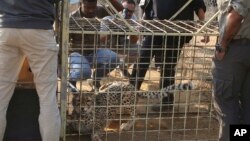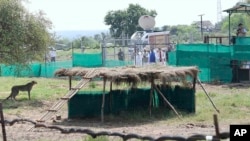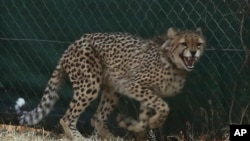Eight African cheetahs that were airlifted from Namibia, were released in Kuno National Park (KNP) in central India, marking the beginning of an ambitious project to reintroduce the big cats after they became extinct in the country some seven decades ago.
On Saturday, Indian Prime Minister Narendra Modi released the first three cats into a quarantine enclosure of the park and said the “long wait is over, the cheetahs have a home in India” at the KNP.
“Project Cheetah is our endeavor towards environment and wildlife conservation,” he added.
The eight radio-collared cheetahs — five males and three females — will undergo a monthlong quarantine before being taken to a larger "soft release enclosure.”
Right now, the cheetahs are in quarantine enclosures after they were released Saturday. There are quite a few quarantine enclosures. After they spend about a month in the quarantine enclosures, they will be transferred to the one “soft release enclosure” which measures about 6 square kilometers. The cheetahs will be kept in the soft release enclosure for two or three months to become acclimated to their new environmental conditions before finally being released in the 748 square kilometer unfenced national park.
Next month, 12 more cheetahs are expected to arrive at KNP from South Africa. Indian authorities have a plan to eventually raise the cat population at the park to around 40, by bringing in more cheetahs from Africa.
The authorities have already released around 250 chitals or Indian spotted deer in the soft release enclosure of KNP where the cheetahs will get used to hunting them. There are no chitals in Africa, so this will be a new prey for the cheetahs.
The cheetah, the fastest land animal, has been rapidly heading toward extinction. The International Union for Conservation of Nature classified the animal as a vulnerable species in a red list of threatened species. In Africa and Asia, the cheetah is “critically endangered.” An estimated 7,000 cheetahs remain in the wild and almost all of them are in Africa.
More than 10,000 Asiatic cheetahs roamed in India during the 16th century, as Islamic Mughal Emperor Akbar chronicled. Hunting, loss of habitat and food scarcity led to the cat’s dwindling population in the country. The cheetah population dropped further during the 19th century, largely because of bounty hunting by local Indian kings and ruling British officials, for the animals’ distinctive spotted coats.
The last three Asiatic cheetahs were hunted down in 1948 by an Indian king in central India. In 1952, India officially declared the cheetah extinct in the country.
In 2009, the government under the leadership of then-Prime Minister Manmohan Singh established Project Cheetah and initiated an effort to revive the cheetah population at KNP by bringing in African cheetahs.
Extinction of the cheetah in India was a massive loss of biodiversity, and the country is undertaking its best effort “to right a historic wrong,” SP Yadav, the chief of India’s National Tiger Conservation Authority, said.
“It is our moral and ethical responsibility to bring back the cheetah to India,” Yadav said.
“We have succeeded in managing the world’s largest wild tiger population in the country. We have the credentials to revive the cheetah population in India.”
Although Indian officials said the Cheetah Project will help restore ecosystems that support the big cats, apart from giving a boost to tourism and the local economy, some conservationists said the project is fraught with challenges.
Many experts said that the KNP space is too small for the big cats.
“In Namibia, the cheetah males either have territories of approximately 400 square kilometers or home ranges of approximately 1,600 square kilometers. And the females have home ranges of approximately 650 square kilometers. Thus, the Kuno National Park in India, with a 748 square-kilometers area, seems too small to maintain a viable cheetah population,” Bettina Wachter, head of the Namibia-based Cheetah Research Project, told VOA.
“The park in India being unfenced, there is a possibility of the cheetahs straying into villages just outside the park and prey on the livestock.”
Indian wildlife biologist Ravi Chellam echoed Wachter noting that the KNP at best can accommodate 10 cheetahs.
“How will a self-sustaining, wild and free-ranging population of cheetahs of at least 50-plus adults, be able to establish themselves in India when there is a severe shortage of quality habitat for them? Currently, India just does not have the required extent of suitable habitat for a wild population of cheetahs,” Chellam, the CEO of Metastring Foundation — an organization working in the field of environment and public health, told VOA.
“Logically, the relatively unglamorous and time-consuming work of restoring, securing and connecting the required extent of habitat should have been done first before bringing the cats from Namibia.”
The cheetahs will face challenges from other carnivores in KNP, Chellam added.
“Carnivores like leopards, striped hyenas, wolves, sloth bear and the occasional tigers, present in the landscape, will pose challenges for the cheetahs. In Africa, lions, hyenas and leopards are known to kill cheetahs. The introduced cheetahs in Kuno will also face similar challenges from leopards and striped hyenas,” Chellam said.
“In the larger landscape, the park being unfenced, domestic and feral dogs will pose a major threat to the cheetahs, too.”






